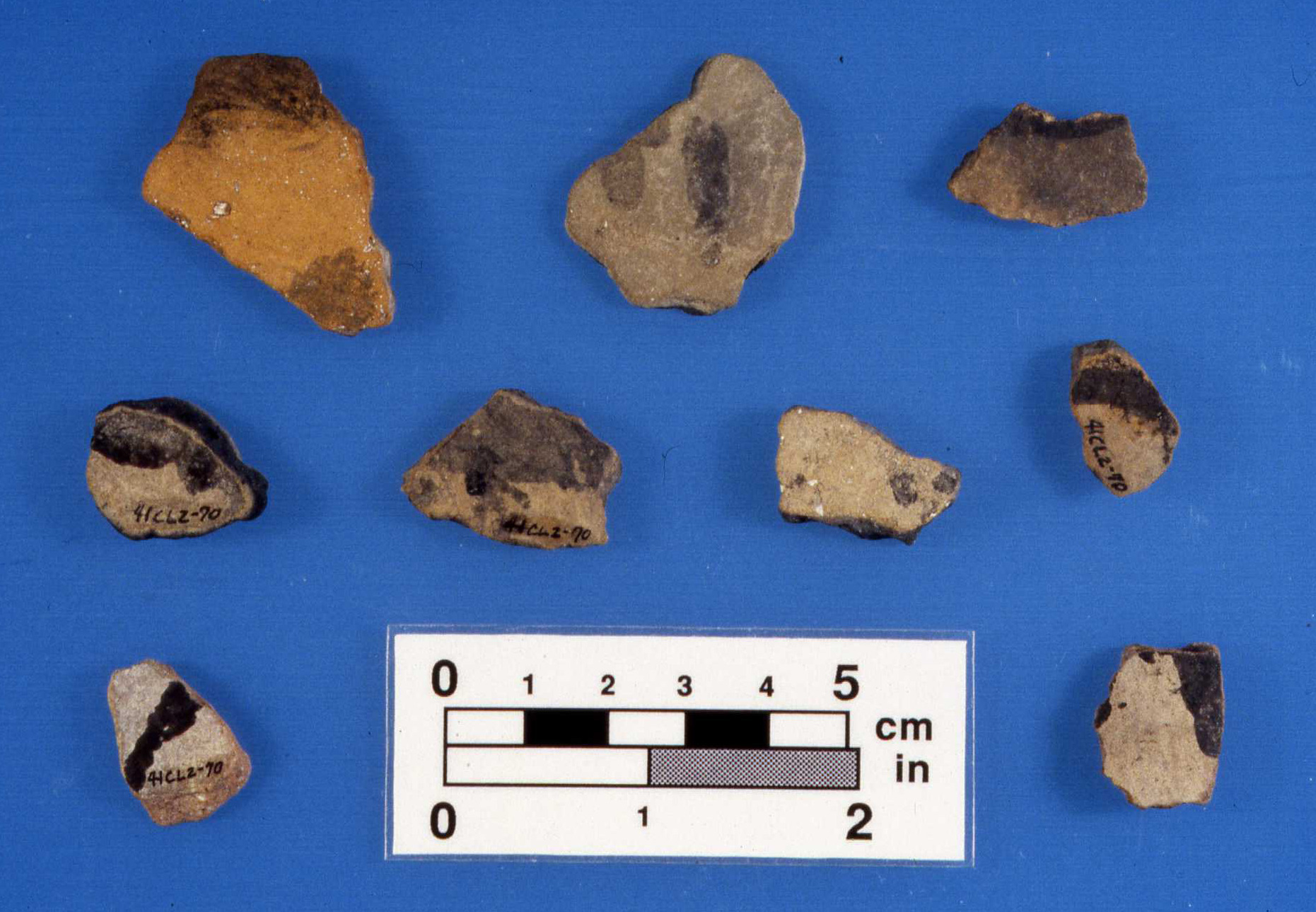
Object: Rockport Black-on-Gray pottery
Date: ca. AD 1350, Rockport II subphase
Context: Central Coast of Texas, Guadalupe Bay site
Texas' central coast (or coastal bend) is the terminus of many of the state's southeast-bound rivers—from the Colorado to the Nueces. At heart of the central coast the San Antonio and Guadalupe Rivers converge just above San Antonio Bay, the uppermost part of which is called Guadalupe Bay. Here, a small bluff below the Guadalupe River delta was frequented by native groups from around 500 BC until the early 1800s. Native American use of the locale was intermittent and seasonal. The people inhabiting the site left discrete layers of occupation debris—stone tools, bone and shell ornaments and tools, shell middens and the remains of other butchered prey including fish, deer, birds and reptiles—and fragments of earthenware pottery, lots of them.
Beginning around AD 1300, the Karankawa Indians who inhabited the Guadalupe Bay site produced and discarded a superabundance of pottery vessels. Archeological excavations at the site, undertaken in 1992 (see Guadalupe Bay: Shoreline Camp between River and Sea), recovered over 42,000 pottery sherds—the largest collection of sherds from a single site on the Texas coast and one of the largest collections analyzed in the state! The overwhelming majority of the pottery found at the site are of a type called Rockport ware. Though no complete vessels were found, the many broken fragments of Rockport Black-on-Gray pottery speak volumes about past lifeways at Guadalupe Bay.
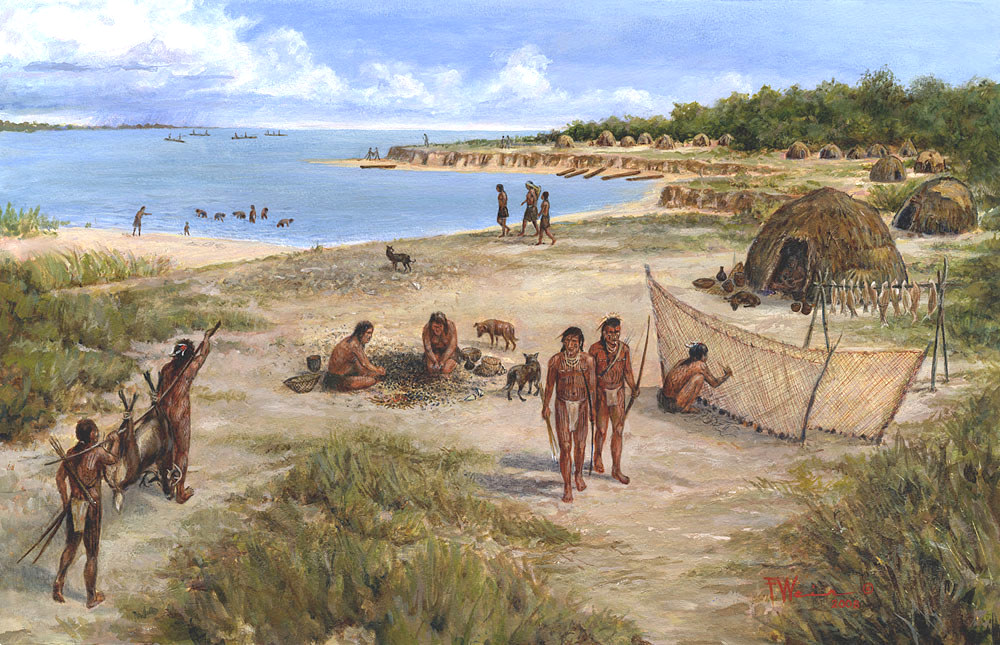
The presence of the distinctive and well-studied Rockport ware indicates the site was occupied by Late Prehistoric ancestors of the Karankawas who encountered Spanish explorers and settlers centuries later. Most of the pottery left at the site dates to the Rockport II subphase (ca. AD 1300-1400), the time period of most intensive habitation of the Guadalupe Bay site. Archeologists hypothesize that during this era 300-500 people from various bands would converge at select coastal locations, such as this one, during the cooler months of the year. At Guadalupe Bay, the remains of seasonally available animals such as ducks indicate that the site served as a village or basecamp in the fall through early spring months, though the site continued to be visited from time to time in the summer months as well.
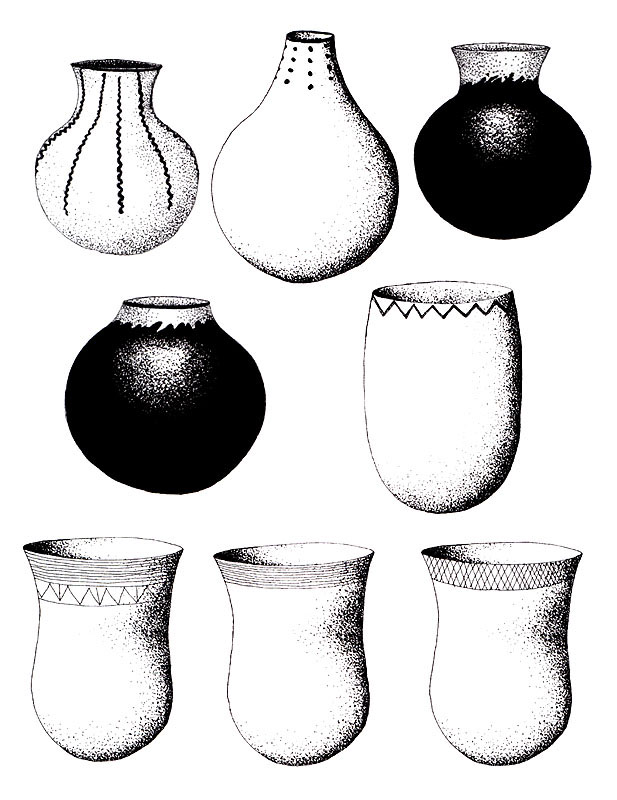
One activity undertaken at the site, likely in the cool season, was making the pottery we call Rockport Ware. Silt and sand comprise the paste (primary constituent of the clay body) of Rockport ware. This fine-grained and compact paste makes Rockport ware harder and more durable than the sandy Goose Creek pottery common on the upper Texas coast. Interestingly, an underlying geologic formation in the area, a Pleistocene-age deposit called the Beaumont Formation, has the same matrix as Rockport paste. In other words, Rockport pottery was made from locally available clay. Crushed bone, shell, or caliche were sometimes added to Rockport paste as temper. The temper provided additional structure to the pottery. Rockport vessels were constructed by the coil method, as were most prehistoric ceramics from North America, and fired at relatively low temperatures.
Analysis of the Guadalupe Bay ceramic assemblage revealed six distinct types of Rockport ware: Plain, Black-on-gray, Black, Red, Polychrome, and Incised. The sherds highlighted here are Rockport Black-on-gray pottery, which was decorated with black asphaltum designs. Over 1600 sherds of Rockport Black-on-gray were found at the site. The asphaltum paint was applied over a light gray or white slip, a fine clay slurry applied after the vessel is formed but before it is fired. To learn more, see Rockport Pottery.
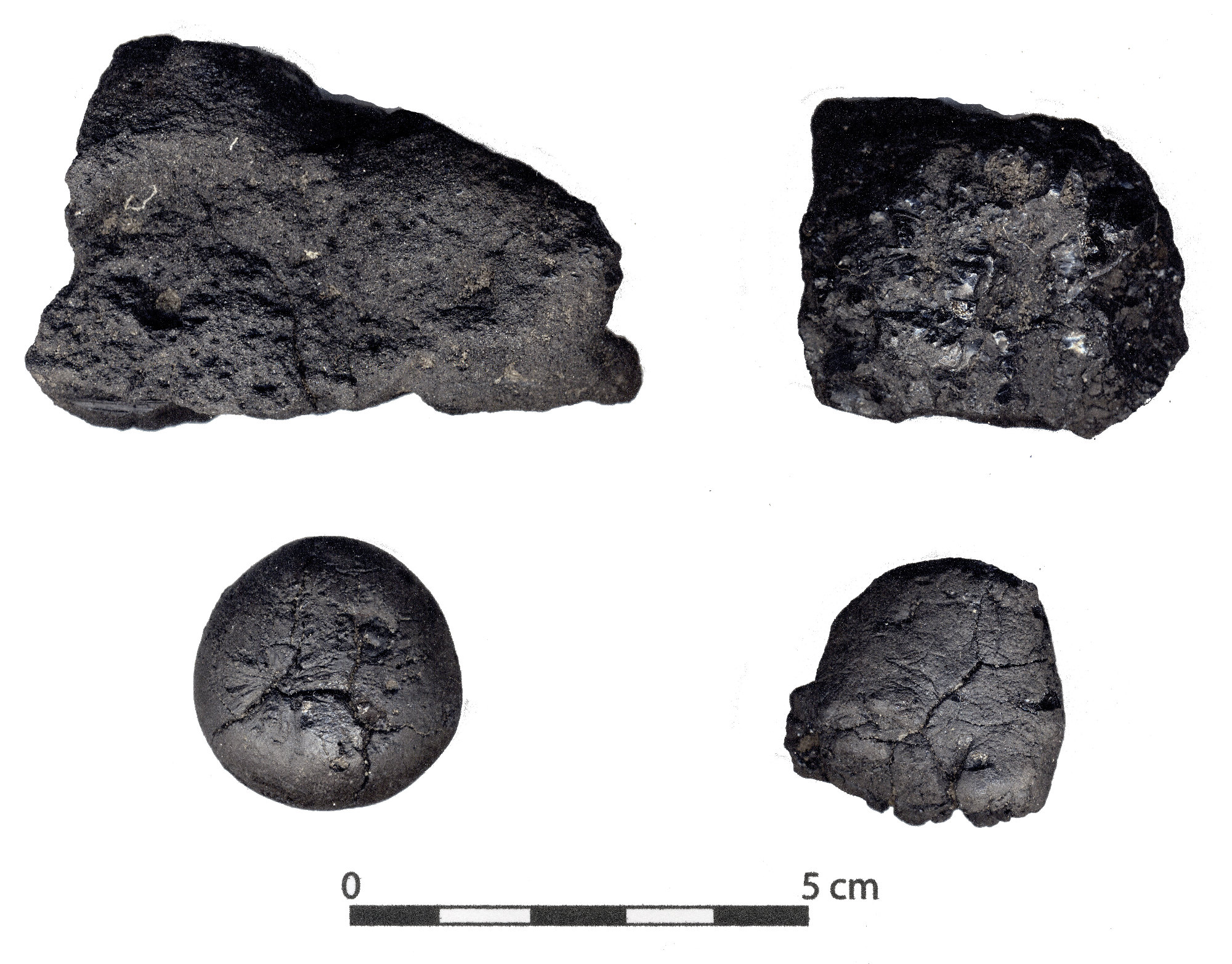
Asphaltum is a naturally occurring petroleum-based pitch or tar which washes up on the Texas coast, as many of today's beach goers know “first foot,” so to speak. Though asphaltum occurs naturally in highly viscous or semi-solid form, when heated the pitch softens and can be applied as a paint, glue, or caulk. Asphaltum was used by native peoples along the coast to haft projectile points and other tools, and even to waterproof the interior of baskets. However, ashaltum is perhaps best known for its use in Rockport ware. Asphaltum was used for decorating pots, mending cracked vessels, and as an interior coating, presumably for waterproofing.
The fact that all of the pottery from the Guadalupe Bay site was broken into fragments (sherds), often small thumbnail-size sherds, presents a challenge for the ceramic analyst. Earthenware pottery is fragile by its nature, more so due to the thermal stress created by using pottery as cooking vessels. Such pottery was intended to be used near where it was made and discarded once it broke, not hauled around on the annual rounds of mobile hunter-gatherer-fishers, such as the Karankawa. And even if the broken Rockport Ware pottery was originally discarded in relatively large fragments, over the centuries the buried pottery continues to breakdown into smaller and smaller sherds. This means that the ceramic analyst must try to refit fragments whenever possible and look for tale-tell patterns that reflect the original design. Analytically reconstructed design patterns are termed motifs. In all, seven motifs were identified in the Rockport Black-on-gray assemblage from Guadalupe Bay.
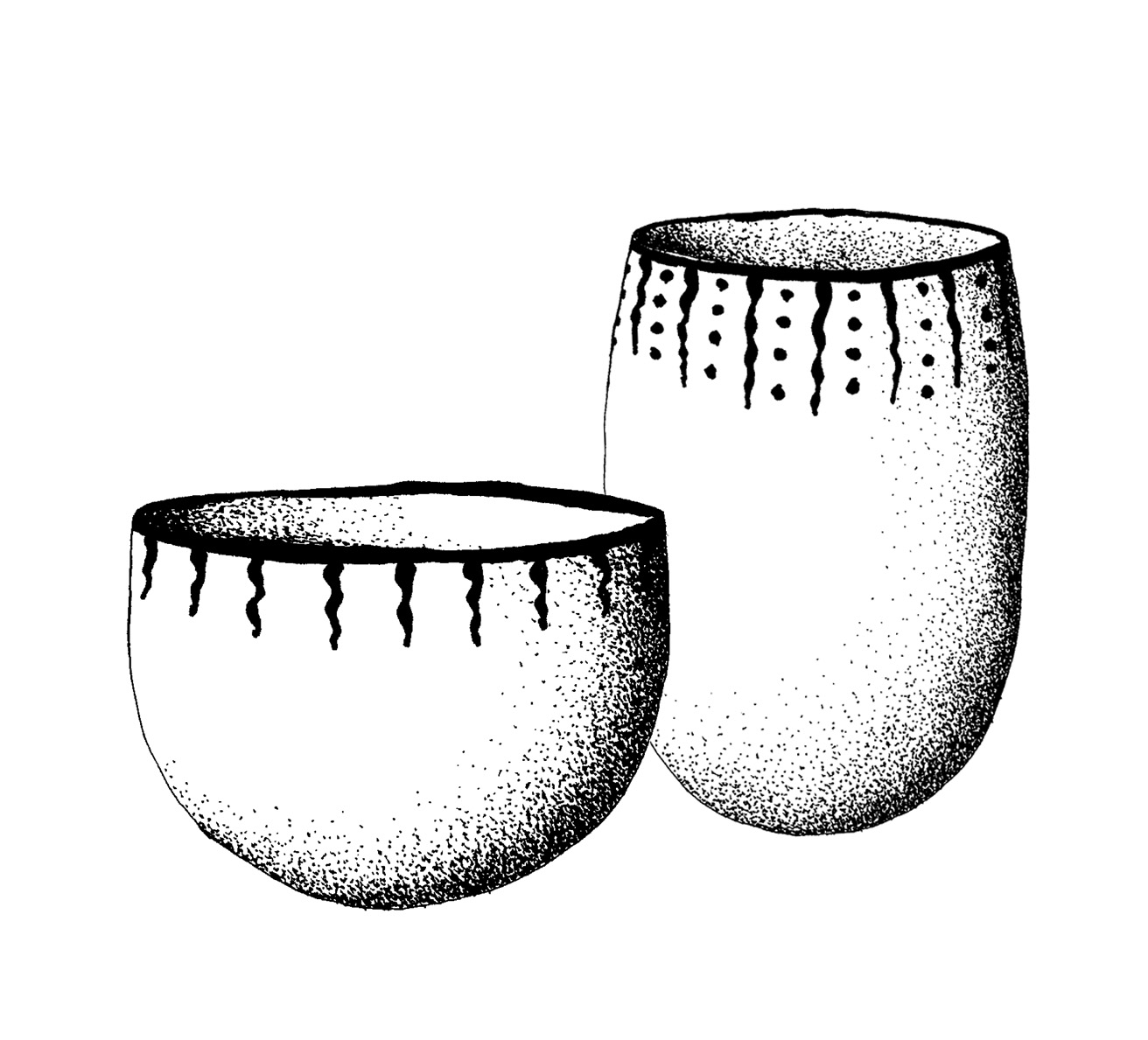
Several of the sherds pictured at the top of the page have wavy black lines of unknown orientation (vertical, horizontal, etc.); over 300 such sherds were recovered from the site. Based on the wavy lines, it can be deduced that the sherds are either of the Matagorda Bay or Turnstake Island motif (design pattern). The Matagorda Bay motif is characterized as having a black band around the vessel lip and squiggly or wavy lines extending vertically down the vessel from the neck. The Turnstake Island motif differs in that it has columns of black dots between the wavy lines. This sherd is too small to confidently ascribe to either motif.
As is standard in ceramic analysis, the Guadalupe Bay analysts looked not only at decorative motif, but at vessel form as well. Though no complete vessels were found, form sometimes can be deduced from rim shape, curvature, and diameter. The Guadalupe Bay vessel forms identified are bowls, bottles, beakers, and jars. Though the sherds pictured here are too small to indicate vessel form, overall, an interesting pattern has emerged in ceramic assemblages at Guadalupe Bay and other coastal sites: plain (undecorated) and incised Rockport vessels have thick walls and smoke blackened exteriors, indicating that they likely served utilitarian purposes. In contrast, the majority of Rockport Black-on-gray vessels have thin walls. These decorated vessels are also more commonly bottles and bowls and less commonly beakers and jars. These differences indicate that the Rockport Black-on-gray vessels were likely “fine ware” reserved for serving, rather than cooking or storage.
The Guadalupe Bay site was excavated in 1992 by archeologists from Coastal Environment, Inc. (CEI) for the U.S. Army Corp of Engineers in advance of widening and dredging of the Victoria Barge Canal, which would ultimately destroy part of the site. The resulting archeological data has contributed greatly to an improved understanding of the 700-year-old Rockport Black-on-Gray pottery tradition.
Credits
Adapted from the TBH exhibit on the Guadalupe Bay site by TBH editorial assistant Emily McCuistion.
Print Source
Weinstein, Richard A., editor
2002 Archaeological Investigations at the Guadalupe Bay site (41 CL 2): Late Archaic through Historic Occupation along the Channel to Victoria, Calhoun County, Texas. 2 Volumes. Coastal Environments, Inc. Prepared for Galveston District, U.S. Army Corps of Engineers..